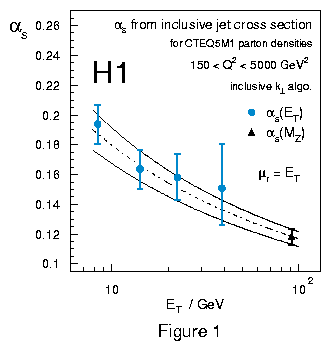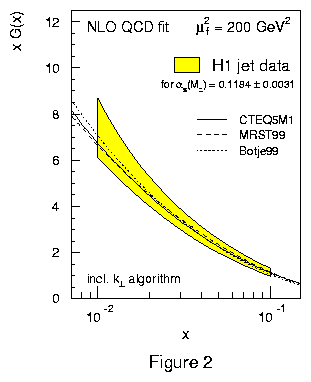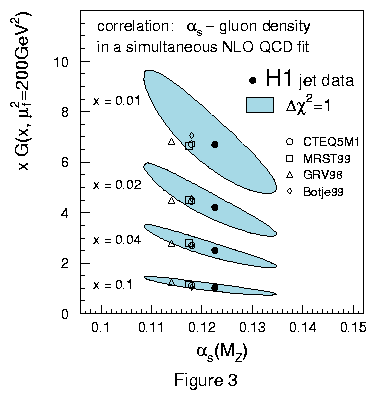

Measurement and QCD Analysis of Jet Cross Sections in Deep-Inelastic Positron-Proton Collisions at sqrt(s) of 300 GeV |
The strong interaction confines the quarks and gluons in the proton,
but it does not play a role on macroscopic scales in everyday's life. In
particle collisions at high energy, however, effects due to the strong
interaction can become directly visible in events in which large numbers
of particles are radiated in small angular regions. These collimated sprays
of particles are called jets.
Studies of the production rates of multi-jet events therefore allow
to investigate properties of the strong interaction and to test the theoretical
predictions of QCD.
While QCD does predict the properties of the interactions between quarks
and gluons it does neither predict the coupling strength alpha_s nor the
distributions of the quarks and gluons inside the proton, the quark
and gluon density functions.
Both alpha_s and the quark and gluon density functions can be determined
from comparisons of the QCD predictions to experimental measurements. In
this analysis the H1 collaboration has carried out a determination of the
strong coupling constant alpha_s and the gluon density in the proton from
inclusive jet and dijet cross sections measured in deep-inelastic positron-proton
collisions.
The H1 collaboration has measured inclusive jet and dijet cross sections in DIS over a large range of momentum transfers Q2 between 5 and 15000 GeV2 and transverse jet energies ET in the Breit frame between 7 and 60 GeV. The results are presented multi-differentially as a function of various variables that describe the dynamics of the underlying hard scattering process. The predictions of QCD which are using the current world knowledge on the strong coupling constant alpha_s and the quark and gluon density functions of the proton give a good description of the data. The large kinematic region and the variety of measured distributions allow for the first time to demonstrate unequivocally the success of QCD in describing jet production in DIS.
 QCD
fits are performed in which alpha_s and the gluon and quark densities in
the proton are determined. Using the world knowledge on the quark and gluon
density functions, the strong coupling constant is determined as a function
of the transverse jet energy ET (figure 1). The observed decrease
of alpha_s towards higher ET is consistent with the theoretical
prediction by the "renormalization group equation", indicated by the lines
in figure 1. A combined fit to all data gives a result which, when extrapolated
to the mass of the Z boson, is alpha_s(MZ) = 0.1186 +- 0.0059.
QCD
fits are performed in which alpha_s and the gluon and quark densities in
the proton are determined. Using the world knowledge on the quark and gluon
density functions, the strong coupling constant is determined as a function
of the transverse jet energy ET (figure 1). The observed decrease
of alpha_s towards higher ET is consistent with the theoretical
prediction by the "renormalization group equation", indicated by the lines
in figure 1. A combined fit to all data gives a result which, when extrapolated
to the mass of the Z boson, is alpha_s(MZ) = 0.1186 +- 0.0059.
Using, alternatively, the world knowledge on alpha_s, the gluon density
in the proton is determined (together with the quark densities) in the
range of proton momentum fractions 0.01 < x < 0.1 carried by the
gluons. The gluon density is seen to increase strongly towards smaller
values of x (figure 2). This result in good agreement with results obtained
in other analyses using different observables.
Last Update October 8, 2000, M. Wobisch